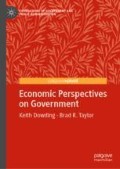Abstract
This chapter introduces the economic or public choice approach to studying politics and public administration. It explains the rationality assumptions as predictive devices and how they are applied to types of agent rather than biological ones. It introduces the idea of formal models to provide predictions and how they can be applied to actual social and political processes. It introduces four concepts central to this way of thinking: opportunity costs, incentives, thinking at the margin and voluntary trade. It then introduces the main themes of several schools of public choice and then introduces the themes of the rest of the book.
Access this chapter
Tax calculation will be finalised at checkout
Purchases are for personal use only
References
Aligica, P. D., & Tarko, V. (2013). Co-production, polycentricity, and value heterogeneity: The Ostroms’ public choice institutionalism revisited. American Political Science Review, 107, 726–741.
Austen-Smith, D., & Banks, J. S. (1999). Positive political theory, I. Ann Arbor: University of Michigan Press.
Becker, G. (1974a). A theory of social interactions. Journal of Political Economy, 82, 1063–1093.
Becker, G. (1974b). Crime and punishment: An economic approach. In G. Becker & W. M. Landes (Eds.), Essays in the economics of crime and punishment. Washington, DC: National Bureau of Economic Research.
Becker, G. (1981). A treatise on the family. Cambridge, MA: Harvard University Press.
Binmore, K. (2009). Interpersonal comparison of utility. In D. Ross & H. Kincaid (Eds.), Oxford handbook of philosophy of economics. Oxford: Oxford University Press.
Boardman, A. E., Greenberg, D. H., Vining, A. R., & Weimer, D. L. (2017). Cost-benefit analysis: Concepts and practice. Cambridge: Cambridge University Press.
Brennan, G., & Buchanan, J. M. (1985). The reason of rules: Constitutional political economy. Cambridge: Cambridge University Press.
Buchanan, J. M. (1975). The limits of liberty: Between anarchy and Leviathan. Chicago: University of Chicago Press.
Buchanan, J. M., & Tullock, G. (1962). The calculus of consent. Ann Arbor: Michigan University Press.
Dowding, K. (2009). What is welfare and how can we measure it? In D. Ross & H. Kincaid (Eds.), Oxford handbook of philosophy of economics. Oxford: Oxford University Press.
Dowding, K., & Miller, C. (2019). On prediction in political science. European Journal of Political Research (forthcoming). https://doi.org/10.1111/1475-6765.12319.
Downs, A. (1957). An economic theory of democracy. New York: Harper & Row.
Gans, J. S., & Leigh, A. (2009). Born on the first of July: An (un)natural experiment in birth timing. Journal of Public Economics, 93, 246–263.
Iannaccone, L. R. (1998). Introduction to the economics of religion. Journal of Economic Literature, 36, 1465–1495.
Laver, M., & Shepsle, K. A. (1996). Making and breaking governments: Cabinets and legislatures in parliamentary democracies. Cambridge: Cambridge University Press.
McKelvey, R. D. (1979). General conditions for global intransitivities in formal voting models. Econometrica: Journal of the Econometric Society, 47, 1085–1112.
Mitchell, W. C. (1990). Interest groups: Economic perspectives and contributions. Journal of Theoretical Politics, 2, 85–108.
Olson, M. (1965). The logic of collective action: Public goods and the theory of groups (2nd ed.). Cambridge, MA: Harvard University Press.
Ostrom, E. (1990). Governing the commons: The evolution of institutions for collective action. Cambridge: Cambridge University Press.
Ostrom, E. (2001). Decentralization and development: The new panacea. In K. Dowding, J. Hughes, & H. Margetts (Eds.), Challenges to democracy. Houndmills: Palgrave.
Ostrom, E. (2005). Understanding institutional diversity. Princeton: Princeton University Press.
Ostrom, E., Gardner, R., & Walker, J. (1994). Rules, games, and common-pool resources. Ann Arbor: Michigan University Press.
Ostrom, V. (1987). The political theory of a compound republic: Designing the American experiment (2nd ed.). Lincoln: University of Nebraska Press.
Peltzman, S. (1976). Toward a more general theory of regulation. Journal of Law and Economics, 19, 211–240.
Phillips, P. J. (2011). Lone wolf terrorism. Peace Economics, Peace Science and Public Policy, 17. https://ssrn.com/abstract=1623573.
Posner, R. A. (2014). Economic analysis of law (9th ed.). New York, NY: Wolters Kluwer Law & Business.
Riker, W. H. (1982). Liberalism against populism: A confrontation between the theory of democracy and the theory of social choice. San Francisco: W. H. Freeman.
Schofield, N. (1978). Instability of simple dynamic games. Review of Economic Studies, 45, 575–594.
Schofield, N. (1995). Coalition politics: A formal model and empirical analysis. Journal of Theoretical Politics, 7, 245–281.
Shepsle, K. A. (1979). Institutional arrangements and equilibrium in multidimensional voting models. American Journal of Political Science, 23, 27–59.
Shepsle, K. A., & Weingast, B. R. (1987). The institutional foundations of committee power. American Political Science Review, 81, 86–108.
Stigler, G. J. (1971). The theory of economic regulation. Bell Journal of Economics and Management Science, 2, 3–21.
Tiebout, C. M. (1956). A pure theory of local expenditures. Journal of Political Economy, 64, 416–424.
Tullock, G. (1967). The welfare costs of tariffs, monopolies and theft. Western Economic Journal, 5, 224–232.
Tullock, G. (1990). The costs of special privilege. In J. E. Alt & K. A. Shepsle (Eds.), Perspectives on positive political economy (pp. 195–211). Cambridge: Cambridge University Press.
Wittman, D. (1995). The myth of democratic failure: Why political institutions are efficient. Chicago: University of Chicago Press.
Author information
Authors and Affiliations
Corresponding author
Rights and permissions
Copyright information
© 2020 The Author(s)
About this chapter
Cite this chapter
Dowding, K., Taylor, B.R. (2020). Introduction. In: Economic Perspectives on Government. Foundations of Government and Public Administration. Palgrave Pivot, Cham. https://doi.org/10.1007/978-3-030-19707-0_1
Download citation
DOI: https://doi.org/10.1007/978-3-030-19707-0_1
Published:
Publisher Name: Palgrave Pivot, Cham
Print ISBN: 978-3-030-19706-3
Online ISBN: 978-3-030-19707-0
eBook Packages: Political Science and International StudiesPolitical Science and International Studies (R0)

